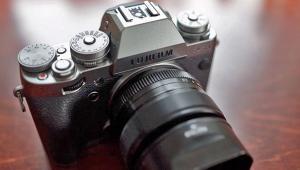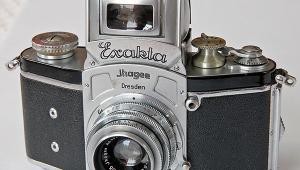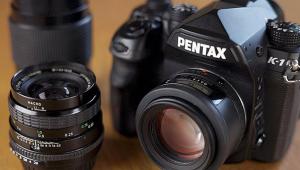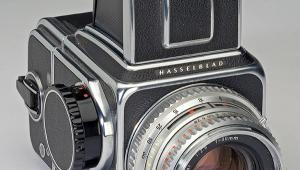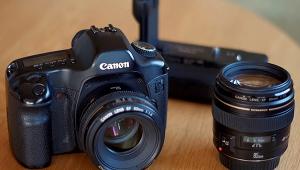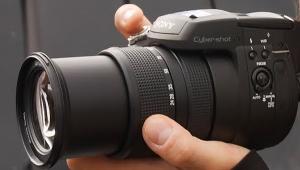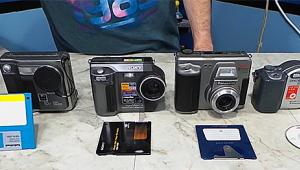The New Zeiss Ikon Rangefinder 35; A Real, Traditional, High-End System
The Zeiss Ikon--hereafter ZI--has all the features you might hope for, plus optional autoexposure. At $1617, the body lists between Leica and Voigtländer. In features, it goes head-to-head with the Leica M7. Because we received the camera and no fewer than six lenses--15mm f/2.8, 21mm f/2.8, 25mm f/2.8, 28mm f/2.8, 35mm f/2, and 50mm f/2--we have split this test between the camera (this month) and the lenses (to follow). The first thing you notice is the clean, angular lines, with a long, smooth, elegant top plate. One reason the top plate is so clean is that the rewind crank is on the bottom. This allows a very long rangefinder base of 75mm, reduced to an effective 55.5mm by the 0.74x viewfinder magnification: the effective base of Leica's 68.8mm RF base ranges from 58.5mm (0.85x) to 39.9mm (0.58x), while that of the Bessa-R series runs from about 35mm (R3A) to about 26mm (most others).
|
The Full Outfit
|
|
 |
|
|
Like the Bessa R2A/R3A, with which the Zeiss Ikon shares a shutter and metering system (but not a chassis), the camera won't work without a battery, either a CR 1/3 lithium or two LR44/SR44. The on/off switch is concentric with the shutter release. More than once we accidentally knocked it to "lock," resulting in the loss of the occasional shot.
Loading And Winding
To load, push the back-catch sideways, then upward. The back then springs open a fraction of an inch. It's reassuringly secure. Loading is very easy indeed: one of the quickest and easiest on any manual-loading camera. There is no DX coding: ISO speeds are set inside the shutter speed dial (lift-twist-drop, ISO 25-3200, 1/3 stop rests). The two most common film speeds, 100 and 400, are printed in red with the remainder in black.
The all-metal wind-on lever has about a 30Þ stand-off and a throw of around 160Þ. It is smooth: not quite as silky as one might have hoped, but smoother with film in the camera. The shutter is admirably quiet, differing slightly in note from the legendary Leica M: a very slightly more obtrusive "click," against the Leica's "clop."
Viewfinder
The bright, clear viewfinder is superb, probably better than the M-series Leica, and the rangefinder patch is again at least as clear and bright as a Leica's. It is very sharp-edged, allowing both coincident and split-image focusing. Rangefinder coupling and frame parallax compensation are automatic down to 0.7m, 28"; if lenses focus closer than this there is no further rangefinder coupling or parallax compensation. For comparison, the Leica MP is coupled down to about 0.65m, 25.6", and the Bessa R-series to 0.8m, 31.5".
Focal lengths from 28-85mm automatically select viewfinder frames in the ZI just as they do in a Leica. The ZI has four frames: 28/85 (displayed simultaneously), 35, and 50. Leica has six, in three pairs: 28/90, 35/135, and 50/75. Both ZI and Leica have frame selector override levers on the front to allow you to check the field of view of other lenses without having to fit them. Both 85mm and 90mm lenses call up the 85mm frame on the ZI and 90mm on Leicas. The four-frame approach of the ZI makes for a much less cluttered viewfinder (a major plus) but obviously you need separate finders for 75mm and 135mm lenses. Three accessory finders are available: 15, 21, and a combined 25/28, at $491 each.
As shown by the accompanying sidebar, the 85mm frame on the ZI is identical to the 90mm frame on the MP. This is no surprise. Viewfinders on rangefinder cameras are seldom very accurate: they typically show 80-90 percent of what will appear on the film. Partly, this is necessary because the angle of view decreases as you focus closer, so a finder that was accurate at infinity would show too much at the minimum focusing distance; partly it is a consequence of the difficulty of deciding exactly what constitutes the border of a brightline frame that apparently moves as the eye is decentered; and partly it seems to be a deliberate choice by the manufacturers to incorporate a "safety margin." Probably the most accurate finder in the table is the old Russian "turret" finder, ironically a copy of a pre-World War II Zeiss design.
|
At A Glance
|
|
 |
|
|
Exposure System
Shutter speeds are 1 second to 1/2000 sec + B, sync at 1/125, clockwise for faster, like all Bessas and all Leicas except the M6 TTL and M7. They occupy just over half the circumference of the large shutter speed dial (diameter 21.6mm, 0.85"). The red "A" in the middle of the other half of the dial gives Aperture Priority automation. There is no lock when switching between auto and manual.
For metering and shooting manually, set the aperture; look through the finder; and half-depress the shutter release. One or two speeds will appear suspended in red on the left of the viewfinder, inside the 28mm frame but outside the 35mm frame. If two appear, one will be steady and the other will flash. The steady speed is the speed set, while the flashing speed is the one recommended by the meter.
If you take your finger off the release, the display extinguishes automatically after about 8 seconds. Unlike the Bessa R2A/R3A, where most reviewers reported making at least one accidental exposure when trying to take a meter reading, unintended pictures are rare, thanks to a much more positive "first pressure" on the release.
As usual, the meter is designed to give optimum exposure with transparency film, where exposures are keyed to the highlights. In black and white, or even with color negative, it is often desirable to set a lower film speed than the true ISO for contrasty subjects where you want good shadow detail. This is not a shortcoming of the ZI: all through-lens meters designed to give good transparencies suffer from the same drawback. With the ZI we followed our usual practice of setting negative film speeds at anything from 1/3 stop lower (EI 80 for ISO 100) on "cloudy bright" days to a full stop lower (EI 200 for ISO 400) in hard, directional sunlight with inky shadows.
Although the metering system works well, with only the usual compensations required for unusual subjects, it has two disadvantages. First, it can be hard to see the shutter speeds in bright conditions. Second, the resolution is limited to one stop. With a "traffic light" system (under-correct-over) as used on Voigtländers prior to the R2A/R3A and on Leica Ms, the resolution can be as accurate as you like: with an MP or R2 it is approximately 1/3 stop, with +/- variations indicated by reduced brightness or two lights on at once.
